Nomadic jewelry traditions showcase both beauty and cultural significance across diverse communities. You’ll discover stunning pieces from the Kochi Tribe’s bold Afghan designs, Tuareg silversmiths’ geometric patterns, Mongolian symbolic metalwork, Bedouin desert-inspired creations, Sámi Arctic adornments, and Berber tribal treasures. Each tradition combines practical function with spiritual protection, using distinctive materials and techniques that tell stories of heritage, status, and identity. These seven cultural origins reveal centuries of craftsmanship passed through generations.
Nomadic Jewelry Traditions: 7 Stunning Cultural Origins
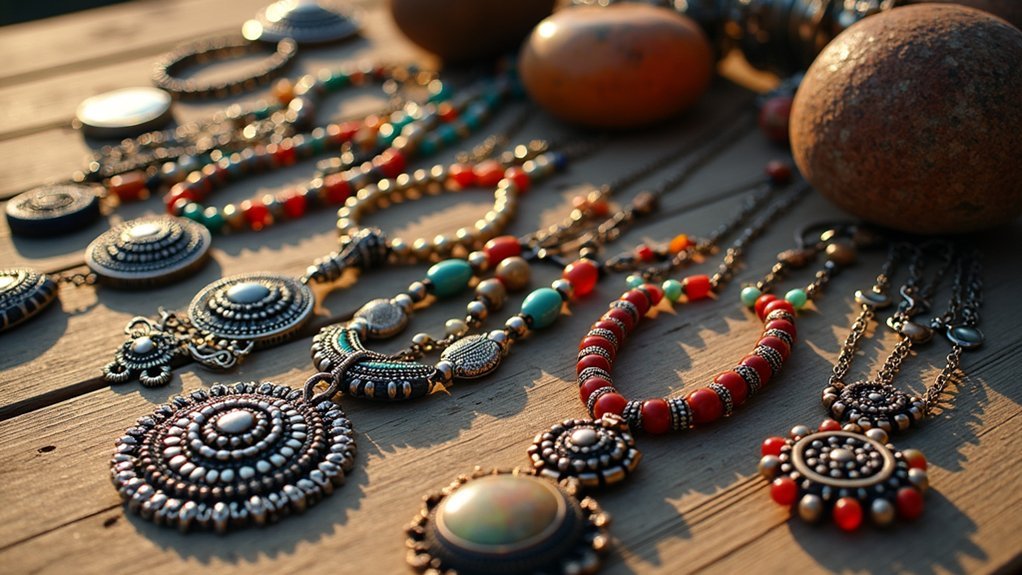
Seven remarkable cultural traditions have shaped nomadic jewelry across continents, each with distinctive styles that tell stories of resilience and beauty.
You’ll find Mongolia’s resourceful artisans crafting intricate jewelry pieces while traveling with minimal tools, demonstrating remarkable adaptability.
The Baule people of Côte d’Ivoire create earrings symbolizing spiritual protection, while Colombia’s Quimbaya Tribe excels in gold craftsmanship that honors their heritage.
These unique jewelry traditions reflect their creators’ values, beliefs, and nomadic lifestyles.
Even today, modern nomadic jewelers continue this legacy in urban environments, transforming ordinary materials into extraordinary pieces.
What makes these traditions special isn’t just their aesthetic appeal, but how they’ve preserved cultural identities despite constant movement, limited resources, and changing environments.
The Kochi Tribe of Afghanistan: Bold Designs for Nomadic Life
You’ll be captivated by the Kochi tribe’s chunky masterpieces, where bold materials and vibrant colors reflect their nomadic heritage and cultural identity.
Their wedding jewelry features large tribal pieces that symbolize ancestral connections and prosperity, creating visual narratives of protection and cultural significance.
Day-to-day, Kochi individuals adorn themselves with practical yet meaningful accessories, often crafted from imported beads strung with cotton fibers, seamlessly blending functionality with their rich artistic traditions.
Chunky Tribal Masterpieces
The Kochi tribe of Afghanistan creates some of the most striking nomadic jewelry in the world, with their chunky designs reflecting both practicality and cultural significance. You’ll notice these tribal jewelry pieces aren’t just decorative—they’re powerful symbols of identity and status within their community.
| Jewelry Type | Characteristics | Cultural Significance |
|---|---|---|
| Wedding Pieces | Bold, elaborate designs | Symbolizes heritage and tradition |
| Daily Accessories | Imported beads with cotton fibers | Demonstrates resourcefulness |
| Status Symbols | Heavy metal with intricate patterns | Indicates position in community |
The chunky jewelry designs are intentionally crafted from robust materials that withstand the demands of nomadic life. When you examine a Kochi piece, you’re seeing generations of artistic tradition translated into wearable art—each element telling stories of their ancestral journeys and cultural resilience.
Wedding Symbolism Unveiled
Among all Kochi tribal adornments, wedding jewelry stands out as the most significant representation of their cultural identity and nomadic heritage.
When you examine these extraordinary pieces of jewelry, you’ll discover profound symbolism woven into every design element.
Kochi brides wear large, statement pieces that connect them to ancestral traditions while signifying their new status within the tribe. The jewelry design isn’t merely decorative—it’s deeply functional for nomadic life, carrying meanings of protection and prosperity.
- Bold materials and chunky elements symbolize strength in marriage and resilience in nomadic life
- Cotton-strung imported beads showcase the tribe’s resourcefulness and trade connections
- Traditional motifs incorporated into wedding pieces tell stories of family lineage and tribal heritage
Daily Adornment Practices
Beyond ceremonial occasions, Kochi tribespeople express their cultural identity through striking daily adornments that serve practical purposes in nomadic life. You’ll notice their chunky jewelry designs aren’t just beautiful—they’re meaningful cultural expressions that tell stories of their heritage.
When traveling through Afghanistan, you’ll spot Kochi people wearing imported beads strung with cotton fibers, creating distinctive beaded necklaces that combine foreign materials with local craftsmanship.
| Jewelry Type | Material | Cultural Significance |
|---|---|---|
| Necklaces | Imported beads | Connection to trade routes |
| Bracelets | Metal alloys | Protection during travel |
| Headpieces | Mixed metals | Status and tribal identity |
These bold accessories aren’t merely decorative—they’re portable wealth and cultural artifacts that reflect the tribe’s nomadic traditions and deep-rooted beliefs about protection and prosperity.
Tuareg Silver Artisans of North Africa
You’ll notice Tuareg silver jewelry’s intricate geometric patterns, forged in the challenging desert environment, instantly recognizable by their sharp angles and precise symmetrical designs.
The Cross Touareg symbol, an iconic element in their metalwork, represents the four corners of the world and serves as both decoration and spiritual protection for the wearer.
These masterful creations carry a rich talismanic heritage, with silver pieces believed to ward off evil spirits and bring good fortune, making them both beautiful adornments and powerful cultural artifacts.
Desert-Forged Geometric Patterns
The shimmering silver works of Tuareg artisans tell stories of desert landscapes through their distinctive geometric patterns. When you examine this jewelry, you’ll discover a rich history spanning generations of nomadic craftsmen who’ve perfected their techniques under the Saharan sun.
Each piece carries profound cultural significance, serving as both protective talismans and status symbols within Tuareg communities.
- Every pattern represents specific meanings—from fertility symbols to spiritual protection—making each piece a wearable cultural narrative.
- Handcrafted using techniques preserved across centuries, ensuring authenticity and connection to ancestral traditions.
- Durable alloys mirror the resilience of desert life, creating pieces that withstand daily wear while maintaining their intricate beauty.
These desert-forged creations aren’t just accessories—they’re tangible connections to North Africa’s nomadic heritage.
Cross Touareg Symbolism
Symbols etched into silver tell profound stories within Tuareg culture, with none more iconic than the Cross of Agadez. You’ll find this distinctive motif adorning numerous pieces worn by both men and women traversing the Saharan landscapes of North Africa.
These meticulously crafted silver crosses aren’t merely decorative—they’re powerful emblems of faith, protection, and social status. When you examine authentic Tuareg jewelry, you’ll notice the remarkable precision of geometric patterns combined with natural elements like leather and semi-precious stones.
During significant ceremonies and weddings, silver adornments become living displays of a family’s wealth and standing. The cross symbolism, passed through generations of skilled artisans, remains a cornerstone of Tuareg identity—a reflection of their enduring nomadic traditions despite the challenges of desert life.
Talismanic Silver Heritage
Silver’s mystical allure within Tuareg culture extends far beyond mere ornamentation, transforming precious metal into powerful talismans that connect wearers to ancestral protection.
These nomadic Berber artisans create breathtaking pieces that serve as both personal adornment and practical currency in North African communities.
You’ll discover that Tuareg talismanic silver heritage represents an integral part of their identity, with each geometric pattern and filigree detail telling stories of lineage and beliefs.
The jewelry’s spiritual significance manifests through intricate craftsmanship passed down through generations.
- Geometric engravings and symbols serve as protective elements, warding off evil and attracting good fortune
- Silver rings and necklaces function as portable wealth, often used in marriage dowries
- Semi-precious stone inlays enhance both the aesthetic appeal and metaphysical properties of each piece
Mongolian Nomads and Their Symbolic Metal Work
Among the vast steppes of Central Asia, Mongolian nomads have developed exceptional metalworking traditions that reflect their deep connection to the natural world.
Their intricately designed silver jewelry serves as both artistic expression and cultural identity markers, featuring motifs of animals and natural elements that hold spiritual significance.
These precious metalworks aren’t merely decorative; they communicate social status and tribal affiliations through ornate belts and pendants.
Artisans employ ancestral techniques like engraving and filigree, preserving craftsmanship that’s been passed through generations.
Today’s Mongolian jewelers honor this heritage while embracing innovation, seamlessly blending traditional symbolism with contemporary design.
When you encounter these pieces, you’re witnessing more than beautiful objects—you’re seeing the embodiment of nomadic philosophy and the continuing evolution of an ancient artistic tradition.
Bedouin Jewelry Traditions Across Arabian Deserts
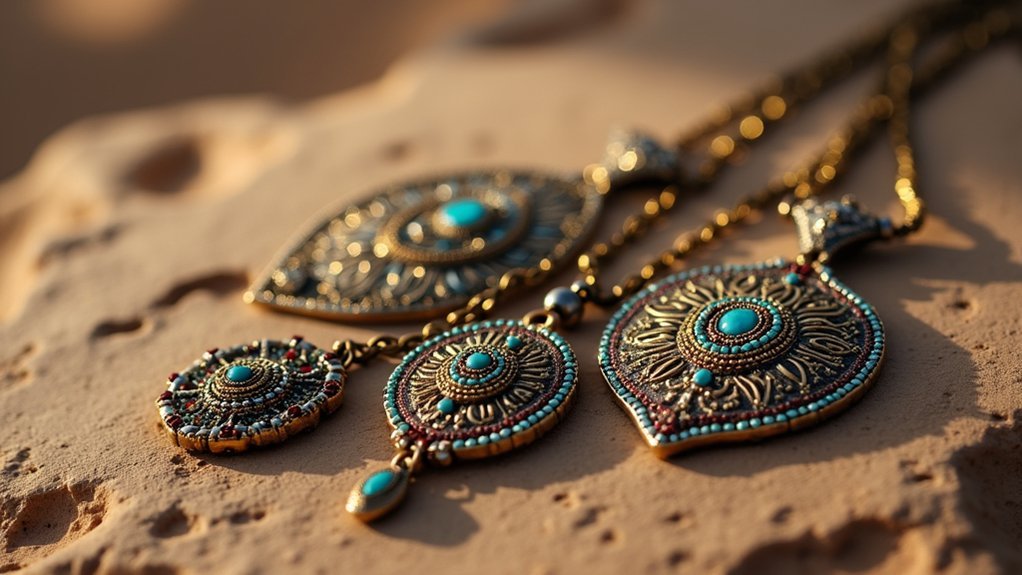
Across the windswept Arabian deserts, Bedouin jewelry stands as a tribute to cultural resilience and artistic ingenuity. Each handcrafted piece of jewelry tells a story—showcasing social status, regional identity, and family heritage through intricate silver designs adorned with vibrant colors from stones and beads.
Ancient artistry captured in silver and stone, weaving Bedouin stories across generations of desert wanderers.
When you encounter Bedouin adornments, you’ll notice how they reflect the harsh desert environment that shaped their creators:
- Elaborate earrings, necklaces, and bracelets featuring geometric patterns inspired by sand dunes
- Silver metalwork incorporating protection and fertility symbols unique to tribal traditions
- Colorful embellishments that contrast dramatically against traditional garments during weddings
During cultural celebrations, Bedouin women proudly display their treasured collections, transforming themselves into living galleries of ancestral craftsmanship that has survived generations of nomadic life.
Sámi Adornments From Arctic Nomadic Communities
Far from the Arabian sands, in the snow-draped landscapes of the circumpolar North, Sámi jewelry embodies the Arctic nomadic spirit through distinctive craftsmanship.
The Sámi people transform silver, reindeer antler, and vibrant beads into wearable art that reflects their intimate connection with nature.
Women’s brooches (bååvve) feature elaborate engravings and filigree work, fastening traditional garments while displaying cultural motifs.
You’ll notice how these symbols represent animals, nature, and heritage—all elements central to their nomadic lifestyle.
A colorful beaded necklace isn’t merely decorative; it communicates social status and identity within the community.
The bright hues stand in stark contrast to the Arctic’s muted palette, celebrating life in a challenging environment.
These jewelry-making traditions continue today, passed through generations as living representations of Sámi cultural resilience and artistic expression.
Berber Tribal Treasures of the Maghreb Region
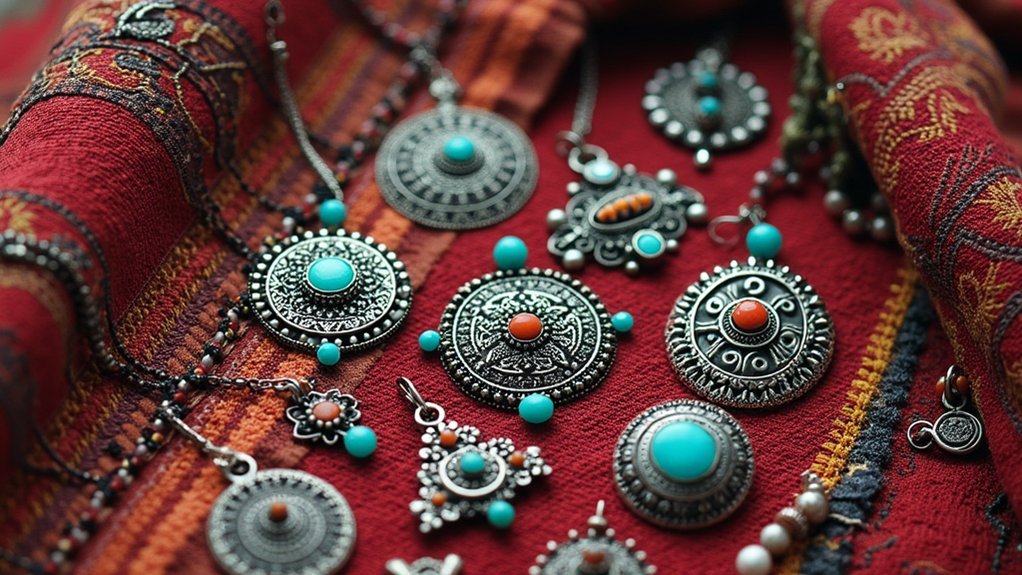
Vibrant storytellers in silver and stone, the Berber jewelry traditions of North Africa’s Maghreb region capture centuries of nomadic wisdom and artistic expression.
When you examine these intricate silver pieces adorned with precious coral, amber, and agate, you’re witnessing a cultural language that communicates status, protection, and family history.
Berber women incorporate these treasures into their daily attire, with specialized pieces reserved for celebrations that connect them to a wider world of symbolic meaning and ancestral narratives.
From ritual adornments to everyday treasures, each Berber piece carries the whispered stories of ancestors across generations.
- Masterful techniques like filigree and granulation showcase the exceptional craftsmanship passed through generations.
- Symbols of fertility and protection grace necklaces, earrings, and bracelets, reflecting deep spiritual connections to nature.
- Each heirloom tells a unique story, preserving family lineage and tribal identity in wearable art.
Frequently Asked Questions
What Culture Did Jewelry Come From?
You can’t attribute jewelry to a single culture. It emerged independently across many ancient societies, including Neanderthals (135,000 years ago), early humans in Israel (100,000 years ago), and Denisovans (70,000 years ago).
Which Culture Has the Best Jewelry?
The “best” jewelry is subjective to your personal taste. You’ll find beauty in Egyptian symbolism, Indian intricacy, Japanese minimalism, or Middle Eastern opulence. Each culture offers unique artistic expressions reflecting their heritage.
Why Do Different Cultures Wear Different Jewelry?
You’ll find that different cultures wear different jewelry because it reflects their unique heritage, religious beliefs, available materials, historical influences, and social status. It’s how they express their identity and traditions.
What Country Is Known for Their Jewelry?
You’ll find several countries renowned for their jewelry. India’s intricate designs, Afghanistan’s chunky pieces, China’s jade work, Bulgaria’s UNESCO-recognized traditions, and Ethiopia’s diverse cultural jewelry are all particularly celebrated worldwide.
In Summary
You’ve now journeyed through seven extraordinary nomadic jewelry traditions spanning continents and centuries. These aren’t just decorative pieces—they’re cultural narratives worn against the skin. As you’ve discovered, each culture transforms necessity into artistry through portable wealth. Whether you’re admiring Tuareg silver or Sámi pewter, you’re witnessing how nomadic peoples carry their heritage, spirituality, and identity in every carefully crafted bead and pendant.

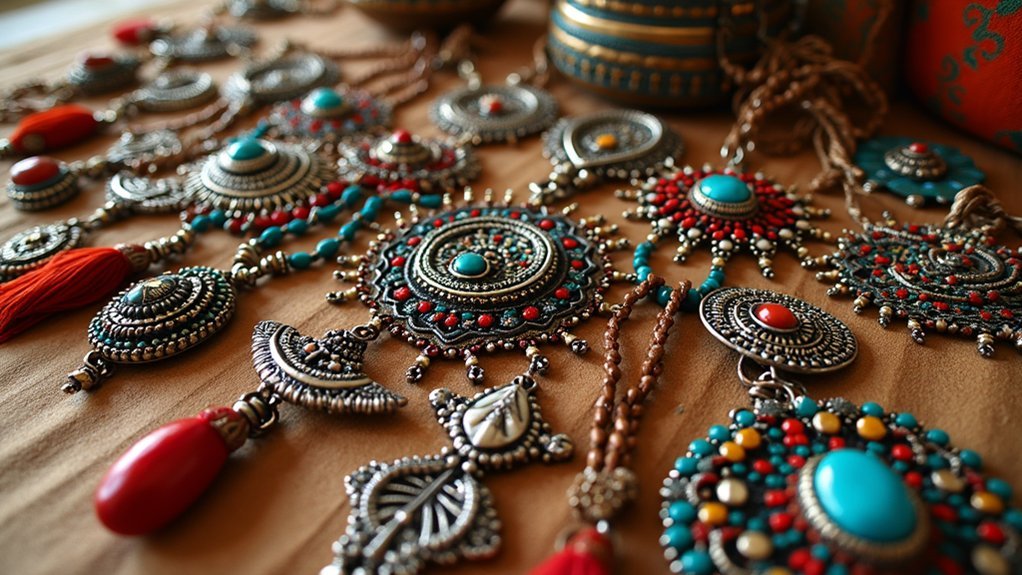

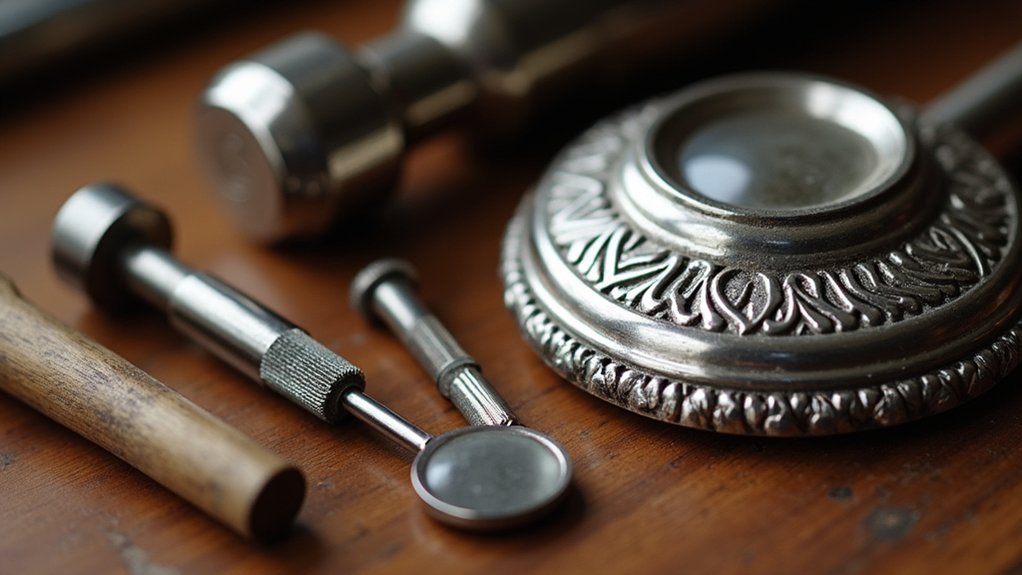

Leave a Reply